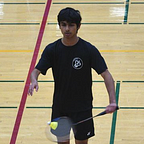The Diversity in American Badminton is Atrocious. Here Are Three Ways To Fix It.
Take a look at this image.
Last year, this team represented the USA at the 2022 BWF World Junior Championships in Spain. The group consisted of the four best male and four best female junior badminton players nationwide. Notice something odd? It might have caught your eye that every member was of Asian descent, particularly of a predominantly Chinese background. It makes sense, as young Chinese-American badminton players make up the vast majority of players in America, so it is only fitting that the best players are all Chinese.
In 2023 approximately 335 million people live in the United States but only about 7.3% or about 24 million people are Asian. But in American badminton, more than 95% of competitive junior players are Asian. This fact highlights virtually zero diversity of the sport in the US. That is a significant factor in why there is very little competitive participation in badminton compared to its sister sport: tennis. In America, where the majority of the population is Caucasian, African-American, or Hispanic, the sport cannot be compromised of all Asians if it wants to be successful in this nation. In the USA Badminton junior tour, approximately 2000 junior athletes compete regularly. On the other hand, there are more than tenfold that in tennis. In tennis, there are players from every corner of the nation and of every ethnicity, and thus, it has so much more participation than badminton.
Turning to the professional leagues, there are fewer than twenty active badminton players representing the USA, and they are all Asian. In contrast, tennis has thousands of players who play pro from America and are a wide variety of races and ethnicities. Because of such a low participation rate on the professional circuit, American badminton is often lackluster and has unimpressive results at almost every tournament.
Badminton, for all it is, deserves so much more than that, so here are a couple of ways badminton could gain more attention and popularity.
- Place badminton gyms in communities where the majority of the population is non-Asian.
The majority of badminton gyms and recreational centers which have badminton courts are only present in Asian-filled regions such as the San Francisco Bay Area, Boston, Los Angeles, and New Jersey, to name a few. Regions with a majority non-Asian population, such as most of the Midwest and the South, have very few places to play badminton, and thus there is no chance for the sport to expand to those areas and those people. Opening gyms and badminton centers in areas where Asians are rarely present can make way for greater diversity in the sport and increase participation as well. It’s vital to market these gyms and centers effectively because most people will be unfamiliar with the sport, so dubious advertising will render efforts useless.
2. USA Badminton can host more tournaments in areas where badminton isn’t as popular.
America’s governing association in badminton, USA Badminton, has already started implementing this idea for its largest tournaments: the US Junior Nationals and the US Open. Since 2018, the US Junior Nationals (JN) have been held in a location with relatively low badminton popularity to promote the sport. I have personally participated in these events, and from my experiences, it was pretty cool going to a place I never thought I would have visited, especially to play a badminton tournament. Thankfully, this plan worked, and the cities where the JN was held noticed an increased participation rate in badminton. After the 2018 JN in Milwaukee, Wisconsin, two new badminton clubs opened, and even a badminton league commenced in the area. Also, the 2023 US Open, a professional tournament part of the HSBC BWF World Tour, will happen this year in Council Bluffs, Iowa. This is significant because it is the first time that the event will take place where badminton isn’t that common. Hopefully, the Council Bluffs/Omaha area can get a large boost of badminton players after this event. This increased effort by USA Badminton to advance the sport is working, and they should continue doing this more and more.
3. Clinics and other promotional events by famed professionals and enthusiastic players can be held.
For anyone looking to promote badminton, hosting clinics at schools in areas where badminton isn’t thriving can help boost the number of players and diversity as well. These events can foster much interest and even lead to school badminton teams being formed. In areas with little badminton popularity, there are often no schools with badminton teams, but interactive clinics can be the spark to change. If enough interest forms, schools will most likely fund badminton teams, and player counts in the United States will rise. Additionally, events such as TEDx and rallies can be the voice of badminton, and they can go a long way in promoting the sport in their respective regions.
American badminton has loads of potential, especially because there are so many people capable of playing the sport of badminton. Although diversity and participation might be small now, we can all work together and elevate this sport into something the badminton community could only dream of. There’s no need to wait. Grab a racket, some shuttlecocks, and a partner, and have fun! I hope you will enjoy the sport as much as I do. I can’t wait to see all the new faces in the sport!
